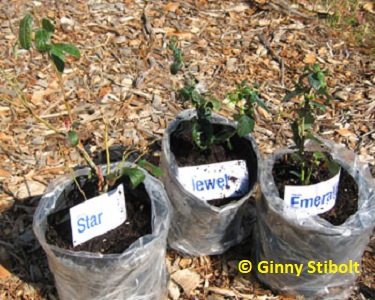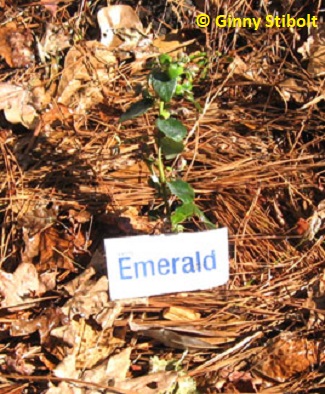Adventures of a Transplanted Gardener |
|||
<< The Emerald variety of the southern highbush blueberry was patented at the University of Florida and released in 1999. I used pine needle mulch to help keep the soil acidic. Blueberry careThe growing instructions included with the plants said to protect them from late winter freezes or the crop will be damaged, since they bloom so early. I planted them near the west-facing wall of the garage where it's warmer and will be easier to protect them from those late frosts (and we have had our share this year). I'll probably need to protect the fruit from the birds, which will also be easier with a wall only three feet away. No manure should ever be used when planting blueberries because it's generally alkaline, and as I mentioned, blueberries require acid soil. The acidic soil reduces the uptake of certain nutrients, so some amendments may be called for with crop plants. When planting trees and shrubs amendments should not be added to the planting hole only–encourage the roots to spread outward by either using only the native soil or by treating the whole planting area. I treated the whole planting area with a two-inch topdressing of compost (with no manure added) and pine needles. (For further information on planting trees and shrubs, see my article: Pot-bound.) I planted them three feet apart and three feet from the wall, watered them in, and then removed all the flowers. Removing the flowers is important so the plants can spend their energy becoming established and putting on growth instead of producing berries during their first year in the ground. After they were planted, I mulched the shrubs with two inches of pine needles, but avoided piling mulch against the stems. Later I will use an acid-based fertilizer formulated for azaleas to compensate for the nearby cement slab, which is alkaline. Some advice stated that it was good to prune the new bushes to half their size, but I did not prune mine since they were already small and appeared to be in good shape. The pruning will be important, as they grow larger since blueberries tend to produce many canes (stems). The consensus is that there should be only six or seven canes on a mature bush and none of them should be more than six years old. Relatively young wood produces the best berries. Blueberries are drought-resistant shrubs, but they need supplemental irrigation for optimum berry production. This is especially true here in Florida because flowering and berry production occurs during our normally dry months. Mine are located next to our new rain barrels, so supplemental irrigation won't be difficult. Even though blueberry bushes in the wild are often located in swampy areas, avoid planting them in waterlogged areas. Blueberries have shallow root systems; so they don't tolerate weeds well. They should grow to about six feet tall within a few years, but next year we should have some blueberries to harvest. More ediblesI look forward to harvesting my own fresh blueberries to add to the edible feast from our yard, and maybe after next year I'll be younger, too after consuming fresh blueberries with their anti-aging properties. I'll let you know how my blueberries do. I hope that you’ll consider growing some blueberries in your yard. (Note: These blueberries have done very well over the years. Read Blueberry Hill to see how they've grown. And I have never done anything to protect them from frosts.) Resources:- Florida Extension Service has a number of articles on growing blueberries in Florida: https://gardeningsolutions.ifas.ufl.edu/plants/edibles/fruits/blueberries.html * USDA scientists attribute the anti-aging effect of blueberries to anthocyanin–the blue pigment. Scientists at the University of Illinois studied a flavonoid that inhibits an enzyme involved in promoting cancer. Of all the fruits tested, blueberries showed the greatest anti-cancer activity. |
|||
|
Ginny Stibolt is a life-long gardener, a botanist, a naturalist, and a garden writer. You may contact her or read more of her articles posted on her website: www.greengardeningmatters.com. |
|||
Copyright Ginny Stibolt



